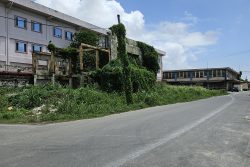The revelation last week that peak demand for electricity was beginning to exceed GPL’s generation capacity appears to have come as something of a surprise to the general populace and apparently the government of the day.
After all we have been told many times that it is transmission related issues which cause the vast majority of the blackouts. For his part the President said he was “disappointed” But in who exactly? Himself and his leadership of the country?
This is akin to a household running out of toilet paper.
Vice President Jagdeo who broke the news, predictably blamed it not on the administration but on 1) hot weather 2) companies going back on the grid thanks to lower tariffs and 3) you guessed it, the previous administration.
For someone so au fait with climate change couldn’t he have predicted warmer weather? Barring that, he could have called up all the air conditioning companies and asked how many more units they had sold in the past three years. As for businesses coming back on the grid this might be overstated although we have no data other than they only make up 30% of total consumption. We can go back and forth on whether the coalition was to blame. Reading various news articles it seems they did in fact add 46MW to the Demerara Berbice Interconnected System.
Anyway the angry, sweltering masses don’t give a rodent’s posterior about that!
What matters is what the current government and GPL have done since coming into office over three years ago and what they are going to do right now. It seems unclear but the fact that this administration which celebrates the opening of an envelope has not said a peep about new GPL generators is an indicator of what has transpired.
Examining the GPL website one sees that under the coalition the company did put out a tender in mid-2020 for a 30MW “firm power generation capacity” with a bid deadline of September 4 of that year. That seems to have been subsequently scrapped.
Then early 2022 (GPL-PD-020-2022) there was another for a 50MW HFO plant to be “interconnected to the 69KW National Grid by March 2023”. There were two further tenders close together in October 2022, one (GPL-PD-063-2022) on October 18 requesting proposals for a 25MW heavy fuel plant and another (GPL-PD-065-2022) requesting proposals for 50MW of HFO-fired Generating Capacity through a Power Purchase Agreement. What happened to these bids is also unclear and there do not seem to be any records on the National Procurement and Tender Administration Board.
Was the government caught flat-footed? They should have not been. The GPL Development and Expansion Plan 2023-27 had warned of potential upcoming shortfalls: “The Loss of Load Probability (LOLP) will be severely violated from year 2023 and onwards. This means that almost every day of year 2024 and onwards there will be blackouts unless more generation is added…” Its own estimate has peak demand in 2023 at the same level Jagdeo said was not expected.
At the same time the President and the VP have been going around boasting about the economic boom. No one can deny that. The non-oil economy grew by 4.6% in 2021, 11.5% in 2022 and for the first half of 2023 at 12.3%. So after three years that will be an increase of 31%.
How exactly did they expect this explosive growth to be powered? How, while they cut ribbons left right and centre, could these two “visionaries” not have seen the convergence of diminishing supply and ever expanding demand? It is mystifying, unless one considers the costs and dynamics surrounding the Wales gas to energy plant.
At the March Environmental Assessment Board hearing into the Wales project, Head of the taskforce Winston Brassington said Wales was not just a power plant but it was about turning off the old plants: “If we did not build this power plant we would have to expand existing plants,” he told former Minister of Public Infrastructure David Patterson while conceding that shutting them down would be a “sunk cost”: to the government. That would include the $35M 2014 plant at Vreed en Hoop and the ($41M) Wartsila generators at Garden of Eden (2021) providing 46MW and inaugurated in 2020.
This may then explain the reluctance to buy new generation capacity for such a short period and why none has been added in the past three years. It might also explain why interest in the bids could have been limited.
The government has now been caught short, waiting on and preparing for the Holy Grail that is Wales. But there is even worse news: those in the know say the transmission lines, the new operational headquarters at Goedverwagting and the project itself are behind schedule and will likely not be operational until mid-2025.
So now, here we are again in what is the traditional festive scramble to bring in second hand generators from Honduras in time for Christmas while the country faces the very real possibility of power rationing.
The President got all Churchillian about it on Saturday saying his government will not shirk from the challenges. Exactly what choice does he have? It’s his country to run or ruin: between the avoidable Mahdia tragedy, a brittle public health system, rising crime and traffic chaos, he’s botching up very badly. Let’s hope at some point he holds his appointees and other officials accountable including those who had the audacity to negotiate with Exxon over the audit and those who did not respond to the urgent recommendations in the UNICEF dormitory report.
This GPL fiasco points to an astonishing culture of incompetence that no amount of money can fix. One would like to compare it to a cake shop but that might be an insult to any such proprietor.
Alas, we will have to cut short this editorial as our laptop battery is running low.








